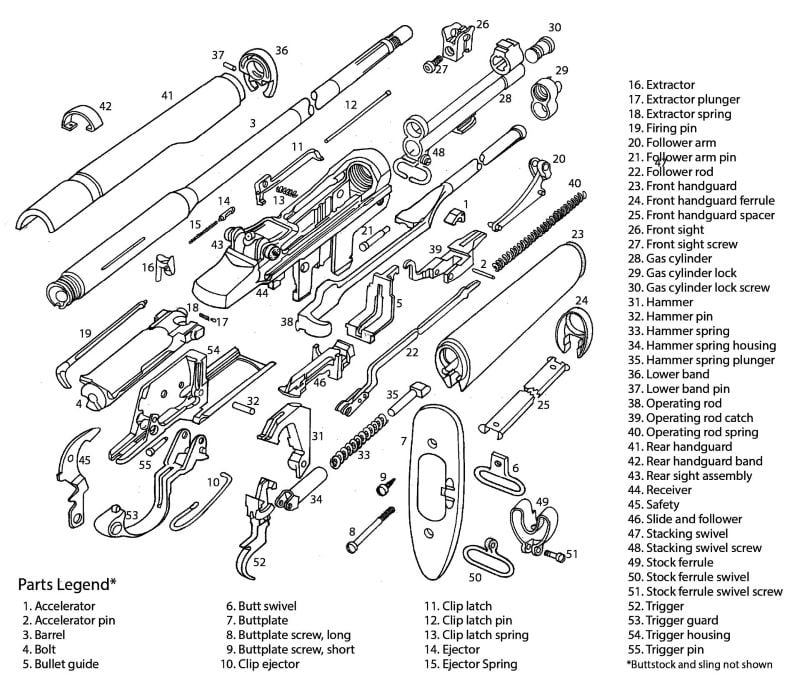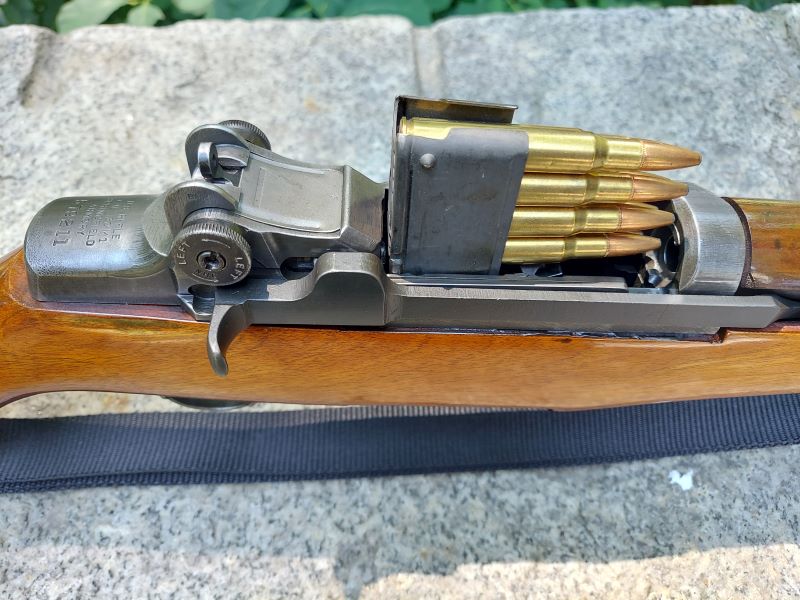Sure, General George Patton praised the M1 Garand as the “Greatest battle implement ever devised.” Keep in mind, Patton commanded armored battalions, so we’d not be shocked if he thought of the tank as being the “finest battle implement.” Instead, he chose the M1 to lavish his praise upon.
Was this one, single rifle really that great, though? Is it deserving of this degree of praise? We’re not only going to answer those questions, but also give you a full background on this fascinating weapon.
The Inception
John C. Garand is the brainchild behind the M1 Garand rifle.
It started back during WWI when the US Army was looking for new machine guns. Garand designed a machine gun and submitted the design. Eventually, that design would morph into the M1 design.
Garand became an employee of Springfield Armory in 1919, bringing with him a solid background in design and production. Springfield Armory tasked him with designing a semi-automatic rifle that was based on that earlier light machinegun design. It didn’t happen overnight, however—the process took the next 17 years! It wasn’t until January 9, 1936, that the M1 Garand was officially adopted. Officially, it was designated, US Rifle, Caliber .30, M1.
The “Cal. 30” that the designation refers to is for the .30-06 Springfield, or 7.62x63mm.
Early M1s used a gas trap as opposed to the later gas port. The trap didn’t work very well, but when the switch was made to the gas port, reliability issues were solved and the rifle was well received.
Technical Specs
The overall length of the M1 Garand is 43.6 inches, with the weight being 9.5 lbs. It is gas operated.
The safety consists of a metal tab mounted at the front of the trigger guard. To take the rifle off safety, the tab is pushed forward, toward the muzzle. To place it on safety, the tab is pushed toward the buttstock.
A rotating bolt is utilized for the action of the rifle, and it locks into place via two locking lugs.
Interestingly, the gas tube of the M1 is made from stainless steel and is the first type of gas tube to be made of this material.
Manuals state that the Garand can be quickly and easily field stripped. I beg to differ with that, as it’s one of the more complex rifles that I’ve ever tried to field strip.

The M1’s sights are some of the finest ever put on a combat rifle. The rear sight consists of an aperture (peep) that has adjustments ranging from 100 to 1,200 yards in 100-yard increments. The clicks are positive. As well, the sights can be adjusted for windage. The front sight is a post that is protected by wings. The sights are easy to see and use, making them extremely effective. In fact, we still see similar sights on today’s M-16 family of weapons that are still in use by the military.
Feeding the Beast
An 8-round En Bloc clip was the method of feeding for the M1. Basically, it’s a spring steel clip that holds eight rounds together. These are fed into the rifle from the chamber area.

When the last round was fired, the empty clip was ejected from the chamber area, exhibiting a distinctive “Ping”. The theory (perhaps a wives’ tale) was advanced that enemy soldiers would sit in wait until they heard the Ping of the clip ejecting, knowing that the GI was now out of ammo, to pounce. Fortunately, this appears to just be a figment of wild imaginations, as there’s no credible documentation that such things ever happened in real life.
When that clip is ejected, the bolt is then held open, ready for another clip to be inserted.
The reason that a detachable magazine was not used at the time was because it was thought that the troops would lose them. Also, detractors believed that the opening for the magazine would allow dirt and debris into the rifle.
I will say that the Ping of the clip being ejected from the M1 is an extremely neat sound to experience if you ever get the chance.
Eight rounds was a decent payload in the M1’s day. However, one negative aspect of the en bloc clip was that the onboard ammo supply couldn’t be topped up; it was an all-or-nothing affair. Troops were known to simply fire the remainder of their ammo if only a few rounds remained, then insert a fresh clip.
It is possible to eject a full or partially expended clip of ammunition that is in the rifle by pressing the clip latch button when the action is held open. The clip and remaining rounds pop out of the chamber area.
Firepower
The M1 Garand was the first general-issue semi-auto rifle of WWII (and as far as any war, to my knowledge). Up until that point, everything was bolt action.

Consequently, adding semi-auto rifles to American infantry squads substantially raised their firepower. Not only did the Americans notice, but so did their enemies; Germany began developing semi-autos of their own, the G-43 being the counterpart to the M1.
Because of the weight of the rifle, coupled with its recoil system, the recoil is fairly tame, which allows a high rate of fire. This, coupled with its accuracy, makes it a very effective weapon. And because it is semiautomatic, the shooter does not have to constantly work a bolt or change position, which contributes to that speed and accuracy.
The fact that the main battle rifles of our enemies were mostly bolt action rifles with a slower rate of fire gave US troops a marked advantage in combat.
The Army was the first to issue the M1, to be followed by the Marines.

Manufacturers
Like most other weapons produced during WWII, the M1 was made by several companies. Springfield Armory, Winchester Repeating Arms, International Harvester, and Harrington & Richardson were the main makers. During WWII, around five million M1 Garand rifles were made. The Korean War saw another 500,000 produced.
Other Models
A few models of the Garand were modified for sniper use (the M1C and M1D). The M1C saw some use during WWII, but it was not widespread at all, as just under 8,000 of them were produced. More of both versions were produced and they saw use in the Korean War.
The much talked about “Tanker” Garand was in the design phase and sported an 18-inch barrel, making it much handier and a little lighter than the standard models. However, it was never issued to tank crews and it is not believed that any saw action in WWII.
The idea was worked on for some time, with prototypes of the “Tanker” versions being tested. The claims why they were not adopted were that muzzle blast and recoil were excessive. Eventually, the idea was shelved.
Many years ago, I owned a “Tanker” Garand (a remake, not an original). I did not find the recoil to be much more than a standard M1, nor was the muzzle blast that catastrophic. My opinion was that the slight increase of the blast and recoil (as small as they were) were greatly worth the lighter weight and better-handling characteristics that the smaller rifle exhibited.
Soldiering On
During the years of WWII, improvements were made to the Garand as it soldiered on through the war.
Even after its use in Korea, the M1 saw use in the early years of the Vietnam war by US troops. And even after newer weapons were issued to US troops, the ARVN used the M1 as well as other US weapons from WWII.

It’s a safe bet that somewhere in the world, there are still some M1 Garands fighting on the front lines in some conflict or another. That’s because a semi-auto rifle that is durable and fires a substantial .30 caliber bullet is still appealing and effective. The fact that these rifles continue functioning decades after they were made is a testament to their design and construction.
Many drill teams still use the M1 Garand today, including the US Marine Corps Silent Drill Team, the Air Force Auxiliary, ROTC and JROTC teams of most US Military branches, US Air Force Academy Cadet Honor Guard, as well as some honor guards overseas.
At the Range
Firing the Garand is a real treat. Recoil is there, but it’s not sharp as it would be in a bolt-action rifle. The M1’s recoil system does an excellent job taming the recoil, turning it into a push on the shoulder as opposed to a sharp jab that other rifles can give.
As you fire the rifle, you can hear the rotating bolt clanking back and forth, which is neat.
Accuracy from most M1s these days is around three inches or so at 100 yards. Naturally, this will vary greatly between rifles, depending on their condition. Some of these rifles have been in operation since the 1940s!
As mentioned, the sound of the clip being ejected is also very neat and unique.
All in all, firing the M1 is a unique, fun experience.
A number of years ago, I had the privilege of talking about the M1 with 101st Airborne paratrooper, Shifty Powers. He loved that rifle dearly and owned one after serving in WWII. He shot it often out behind his house. It’s hard to find a better endorsement than that.
The Final Word
From shortly before WWII until well into the Vietnam War, the M1 fought for our country valiantly. It gave our soldiers and Marines exactly the tool that they need to emerge victorious through all of these conflicts. On top of that, the US gave the M1 to other countries, who also used it to fight.
It is reliable and examples still are in operation some 86 years later as this is written. Competitors in high-power rifle competitions are still using it to compete these days. That is a huge testament to the design!
Yes, I believe General George Patton had it right when he heaped praise upon the M1 Garand.


